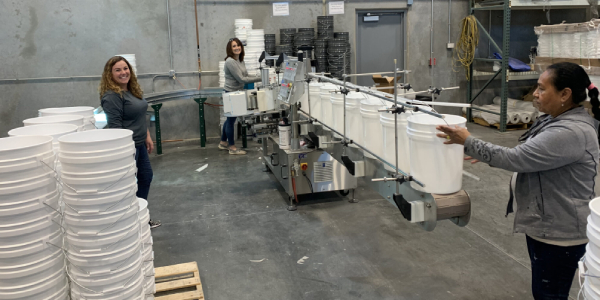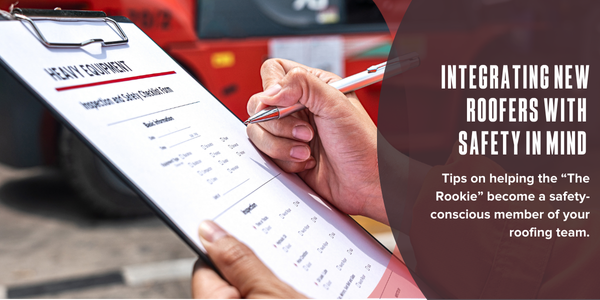Top Nail Gun Safety Tips for Roofers

By IKO.
As a residential roofer, one of your top tools will be a roofing nail gun (often called a “roofing nailer”).
The roofing nailer will help you fasten shingles or other roofing materials, such as underlayments, quickly and efficiently.
Although there are other types of nail guns available – such as siding nail guns – manufacturers have developed specific nail guns for roofers – these use roofing nails and are designed to install the nail tight to the shingle.
The advantages of using a roofing nail gun
Roofing nail guns are widely celebrated for making shingle installation more efficient – roofers find nail guns help them install shingles faster and feel less tired afterward, versus manually pounding in each nail.
However, as with all power tools, nail guns bring with them important safety considerations users must keep in mind at all times. Thanks to their fast application, nail guns boost productivity in a wide variety of contracting jobs; however, nail guns also cause tens of thousands of painful injuries each year, according to the Occupational Safety and Health Administration (OSHA). In Canada, some experts estimate up to 30% of workers have experienced an injury at the hands of a nail gun.
By becoming familiar with common nail gun safety rules, you’ll be able to complete your work confidently and easily – all while knowing you’re reducing your chance of injury.
What’s at risk?
More than half of nail gun injuries happen to the hands and fingers, and can cause damage to the tendons, joints, nerves, and bones. The next more common type of nail gun injury is to the leg, knee, thigh, foot, and toes. Less common, but still reported, are injuries to the forearm or wrist, head and neck, and trunk – all of which can lead to painful or long-term damage to your body. (Source: OSHA.)
Different types of nail gun power sources
There are three general types of power sources for nail guns: pneumatic, fuel powered, and battery powered, each with different advantages and drawbacks.
1 - Pneumatic nail guns
Pneumatic nail guns are hooked up to air compressors to allow for forceful insertion of the nail into the working material. Pneumatic nail guns allow plenty of power, but take a few seconds to build up pressure, unlike fuel powered or battery powered nail guns.
When choosing this type of tool, ensure the air compressor you buy along with it is compatible with your nail gun (manufacturer guidelines will specify which compressor to look for).
There is a considerable price advantage with these nail guns: they can run as little as half the cost of a cordless version.
A note about air compressor safety – Any pneumatic power tools that use compressed air, like nail guns, are regulated by OSHA. Familiarize yourself with their regulations for pneumatic power tools, which include requirements like: securing the hose, safety devices for the muzzle attachment, safe operating air pressure levels and proper hoisting techniques. Also, ensure your gun is unhooked from the air compressor when not in use to prevent accidental firing.
2 - Fuel powered nail guns
These operate with an attachable fuel chamber that uses an electrical spark to ignite and burn the fuel (such as butane). They are fast and powerful, but the cartridge must be changed regularly. These cost more than the traditional pneumatic nail gun.
3 - Battery powered nail guns
Although these don’t offer the same power as the first two types of nail gun power sources, battery-powered nail guns can be handy for getting into hard to reach places. With a rechargeable battery, you can cut down on the cost of using non-reusable fuel cartridges as you do with a fuel powered nail gun.
Like the fuel powered nail gun, battery powered nail guns remove the need to worry about an air compressor hose on the roof.
(Source: Tool for Home, WoodWorkers Guild of America.)
Top nail gun safety tips
OSHA offers these top six nail gun safety tips. We dig into each one below to make them easy to follow and part of your everyday routine.
Working each of these steps into your work on the job site will make it easier to stay safe and prevent injuries.
- Use a full sequential trigger
- Provide/attend training
- Establish nail gun work procedures
- Provide Protective Personal Equipment (PPE)
- Encourage reporting and discussion of injuries and close calls
- Provide first aid and medical treatment
Review OSHA’s complete Guide to Nail Gun Safety here.
In review: Quick list of nail gun safety tips
Refer to this list for an easy refresher on properly – and safely – using your nail gun.
- Use a full sequential trigger
- Never modify safety features of a nail gun
- Read and understand all instructions and warnings related to your nail gun
- Ensure all bystanders are a safe distance away from you while you use your nail gun
- Keep the gun at least 12 inches away from your body when using it (but refer to specific manufacturer instructions for each nail gun)
- Point the tool away from your body when firing
- Remove your finger from the trigger when not using the nail gun
- Keep your hands, feet and other body parts away from the line of fire when discharging a nail
- Never point the nail gun at anyone – even if your finger is off the trigger
- Disconnect the nail gun before performing any maintenance work on it
- Always wear personal protective equipment
- Never fire a nail gun unless the nose is pressed squarely against the material
Keep safe and your work will show the results
OSHA and other nail gun safety suggestions have been compiled based on statistics and real-life stories of worker injuries. By following these nail gun rules and suggestions, you can reduce your risk while still making the most of this handy instrument. This will give you a leg up in the industry, and put a powerful tool in your arsenal to continue creating beautiful, lasting roofs for your clients.
The information and safety tips contained in this article are intended as general information only, and are not a substitute for proper live training and compliance with all local occupational health and safety rules, regulations, guidelines and recommendations.
Editor’s note: This is an excerpt from an article that first appeared on IKO’s blog and the full article can be viewed here.






















Comments
Leave a Reply
Have an account? Login to leave a comment!
Sign In